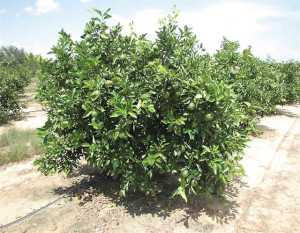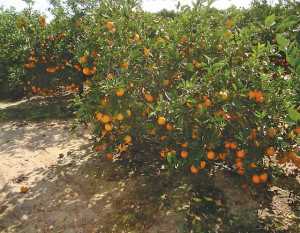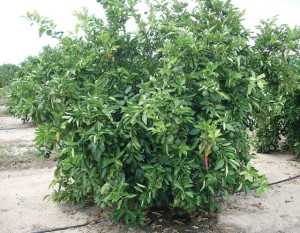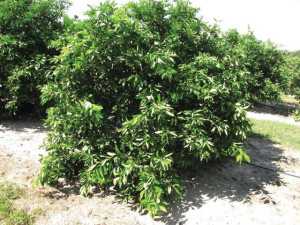4 New Citrus Rootstocks To Grow On
In late 2013, UF/IFAS approved the release of several new citrus rootstock varieties under its Citrus FAST TRACK release option. Under the program, new and experimental citrus selections are released at the request of the industry without having gone through the standard replicated trials that are traditionally completed for new cultivars released by UF/IFAS. This release option was implemented to rapidly provide potential solutions to Florida’s citrus industry. These citrus rootstocks have been released based on their limited experimental performance in trial sites under severe disease pressure from HLB. It is important to note trees on these new rootstocks still require thorough psyllid control, and that the rootstocks have performed best under experimental production systems featuring constant nutrition.
In January, Florida Foundation Seed Producers Inc. (FFSP), a direct support organization of the University of Florida that is responsible for licensing new plant varieties, announced the opportunity for Florida citrus nurseries to obtain a license agreement for the following rootstock varieties:
1. UFR-2 (U.S. Patent Pending)
- Seed available
- Tissue culture (TC) liners available
- Experimental Designation: Orange 4
- Tetraploid
- Medium yield¹
- Low-to-medium HLB²
- Potential salinity tolerance
- Medium-sized tree
- Medium fruit quality
- Medium confidence; good at three locations, better on the Ridge,
- less impressive in flatwoods; is showing promise as a rootstock
- for mandarin scions³
2. UFR-3 (U.S. Patent Pending)
- Seed available
- TC liners available
- Experimental Designation: Orange 15
- Tetraploid
- High yield¹
- Low HLB²
- Small-to-medium tree
- Medium fruit quality
- High confidence; good at St. Helena trial; good for advanced citrus production systems (ACPS)³
3. UFR-4 (U.S. Patent Pending)
- Seed available
- TC liners available
- Experimental Designation: Orange 19
- Tetraploid
- Medium-to-high yield¹
- Low-to-medium HLB²
- Medium-sized tree
- High fruit quality
- High confidence; potential blight tolerance; diaprepes/phytophtora tolerance; good at four locations; good for ACPS³
4. UFR-16 (U.S. Patent Pending)
- Seed available
- Experimental Designation: 46×31-02-13
- Diploid, sour orange type
- No yield data
- Low-to-medium HLB²
- Medium-to-large sized tree
- Medium-to-high confidence; performing well at St. Helena; four-year old, HLB positive tree growing³
Nurseries To Know
Nurseries are required to have a license with FFSP for the propagation, sale, and/or use of these varieties. As of March, FFSP has non-exclusively licensed 13 Florida citrus nurseries for the propagation and sale of citrus trees budded onto the four aforementioned rootstock varieties. Those nurseries are:
- Agri-Starts Inc.
- Ben Hill Griffin Inc.
- Brite Leaf Citrus Nursery LLC
- CitriSun Nurseries LLC
- Gose Growers Inc.
- Himrod Citrus Nursery
- Orange-Co LP
- Phillip Rucks Citrus Nursery Inc.
- Rasnake Citrus Budding & Growing Inc.
- Southern Citrus Nurseries LLC
- W.W. Citrus Nursery
- Ward’s Nursery Inc.
- Wright Citrus Nursery
Anticipated Commercial Availability
There are three distribution methods to make this material available to citrus nurseries for their use in increasing plant material. These distribution methods are:
1. Distribution of seed
a. In March, seed extracted from DPI-certified seed source trees was equally divided and distributed to licensed nurseries. Nurseries receiving seed are responsible for culling zygotic seedlings which may arise. Due to the fact seed is presumed to be “clean,” it is anticipated that nurseries will use the seed received to establish mother trees (under DPI-approved protected structures) as well as seed trees (outside of protected structures).
2. Distribution of liners produced from tissue culture stock
a. The UF/IFAS citrus breeding program has previously provided seed to a commercial citrus nursery under a Materials Transfer Agreement for this nursery to establish these rootstock varieties in-vitro. This citrus nursery will be able to produce tissue culture liners and will make these liners available for purchase by other FFSP-licensed citrus nurseries. These nurseries will then be able to use the rootstock liners to bud commercial scion varieties and also will be able to generate additional rootstock liners through the use of vegetative cuttings, which can be taken from the tissue culture rootstock liners that they receive, or to establish their own seed source trees. It is expected this method will lead to the most rapid deployment of these rootstock varieties, as once the varieties are established in-vitro, a large quantity of liners can be rapidly produced and distributed. If so desired, additional FFSP-licensed nurseries also will have the opportunity to establish these rootstock varieties in-vitro.
3. Distribution of buds from DPI-Chiefland
a. The DPI Parent Tree Program (PTP) clean-up process has recently been completed for these rootstock varieties, but currently, extremely limited amounts of certified budwood exist, and widespread distribution from the DPI facility in Chiefland to FFSP-licensed citrus nurseries is not yet possible. Budwood trees of all these rootstock varieties will be established in Chiefland; then, FFSP-licensed nurseries will be able to obtain buds from DPI-Chiefland to establish mother trees within their nurseries under DPI-approved protected structures. Nurseries can then use vegetative material from these mother trees to propagate liners of the rootstocks onto which they can bud commercial scion varieties. Alternatively, the mother trees also can serve as seed source trees for FFSP-licensed citrus nurseries.
If you or your company are interested in purchasing citrus trees budded onto any of these four rootstock varieties, please contact any one of the licensed nurseries listed above to determine commercial availability and/or place orders. If you or your company are authorized to propagate citrus trees in the State of Florida and are interested in obtaining a license, please contact FFSP (ffsp.net, 352-273-3656).
If you have any technical questions regarding these rootstocks, please contact Dr. Jude Grosser ([email protected], 863-956-8680 ext. 18680).
References
¹ As yield varies according to a host of conditions, it is rated for the age and size of tree based on the scientist’s experience and judgment in comparison to trees on Swingle or Kuharske.
² Rating for leaf symptoms, and overall tree appearance and condition regarding HLB incidence and severity.
³ Given that the data/info available is less than what would ordinarily be used to assess a rootstock in some instances, a
description of a rootstock’s attributes as known is provided along with the researcher’s professional opinion regarding potential.
Information for this article was provided by John Beuttenmuller of the Florida Foundation Seed Producers.









